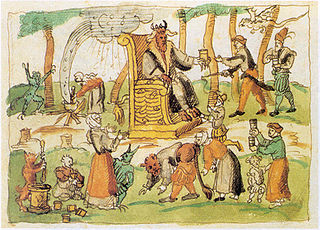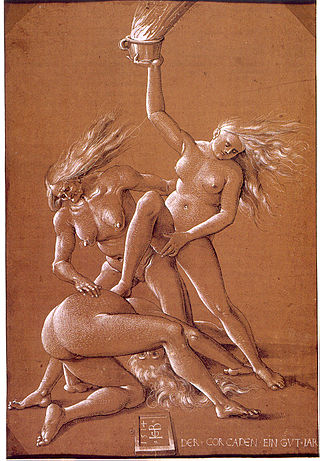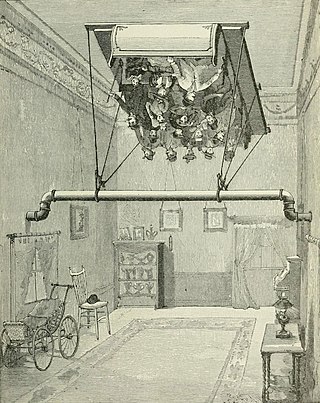Related Research Articles

Witchcraft traditionally means the use of magic or supernatural powers to harm others. A practitioner is a witch. In medieval and early modern Europe, where the term originated, accused witches were usually women who were believed to have used malevolent magic against their own community, and often to have communed with evil beings. It was thought witchcraft could be thwarted by protective magic or counter-magic, which could be provided by cunning folk or folk healers. Suspected witches were also intimidated, banished, attacked or killed. Often they would be formally prosecuted and punished, if found guilty or simply believed to be guilty. European witch-hunts and witch trials in the early modern period led to tens of thousands of executions. In some regions, many of those accused of witchcraft were folk healers or midwives. European belief in witchcraft gradually dwindled during and after the Age of Enlightenment.

The Salem witch trials were a series of hearings and prosecutions of people accused of witchcraft in colonial Massachusetts between February 1692 and May 1693. More than 200 people were accused. Thirty people were found guilty, 19 of whom were executed by hanging. One other man, Giles Corey, was pressed to death after refusing to enter a plea, and at least five people died in jail.

A Witches' Sabbath is a purported gathering of those believed to practice witchcraft and other rituals. The phrase became popular in the 20th century.
Peter Binsfeld was a German auxiliary bishop and theologian.

Christian demonology is the study of demons from a Christian point of view. It is primarily based on the Bible, the interpretation of these scriptures, the writings of early Christianity philosophers, hermits and the associated traditions and legends incorporated from other beliefs.

A witch doctor was originally a type of healer who treated ailments believed to be caused by witchcraft. The term is now more commonly used to refer to healers, particularly in regions which use traditional healing rather than contemporary medicine.

The Church of Satan: A History of the World's Most Notorious Religion is a book by Blanche Barton, published on November 1, 1990 by Hell's Kitchen Productions.

A deal with the Devil is a cultural motif exemplified by the legend of Faust and the figure of Mephistopheles, as well as being elemental to many Christian traditions. According to traditional Christian belief about witchcraft, the pact is between a person and the Devil or another demon, trading a soul for diabolical favours, which vary by the tale, but tend to include youth, knowledge, wealth, fame and power.

George Burroughs was an American religious leader who was the only minister executed for witchcraft during the course of the Salem witch trials. He is remembered especially for reciting the Lord's Prayer during his execution, something it was believed a witch could never do.

"Tam o' Shanter" is a narrative poem written by the Scottish poet Robert Burns in 1790, while living in Dumfries. First published in 1791, at 228 lines it is one of Burns' longer poems, and employs a mixture of Scots and English.
Mary Ann Warren was the oldest accuser during the 1692 Salem witch trials, being 18 years old when the trials began. She was a servant for John and Elizabeth Proctor. Renouncing her claims after being threatened to be hanged, she was later arrested for allegedly practicing witchcraft herself. Her life after the trials is unknown.

Belief in witchcraft in Europe can be traced to classical antiquity and has continuous history during the Middle Ages, culminating in the Early Modern witch trials and giving rise to the fairy tale and popular culture "witch" stock character of modern times, as well as to the concept of the "modern witch" in Wicca and related movements of contemporary witchcraft.

El Retorno de Walpurgis is a 1973 Mexican-Spanish co-production horror film that is the seventh in a twelve-film series about the werewolf Count Waldemar Daninsky, played by Paul Naschy. This film ignored the events in all of the earlier Wolf Man films and began an entirely new origin for el Hombre Lobo, which is strange because the film's Spanish title The Return of Walpurgis seems to tie it in with Naschy's earlier 1970 film Walpurgis Night. The Wolf Man makeup was done by Fernando Florido. The film was shot in June 1973, and by September, it was already in theaters in Spain, as El Retorno de Walpurgis. It wasn't released theatrically in the U.S. however until 1976, as Curse of the Devil.
Witch trials in the early modern period saw that between 1400 to 1782, around 40,000 to 60,000 were killed due to suspicion that they were practicing witchcraft. These trials occurred primarily in Europe, and were particularly severe in some parts of the Holy Roman Empire. Some witch hunts would last for years, and some sources estimate 100,000 trials occurred. Groundwork on the concept of witchcraft was developed by Christian theologians as early as the 13th century. However, prosecutions for the practice of witchcraft would only reach a highpoint from 1560 to 1630 during the Counter-Reformation and the European wars of religion, with some regions burning those who were convicted at the stake, of whom roughly 80% were women,, mostly over the age of 40.
The possession of Elizabeth Knapp of Groton, Massachusetts was documented by Samuel Willard, a prominent preacher in the Puritan, Massachusetts Bay Colony from October 30, 1671 until January 12, 1672. More significantly, Willard sent letters to the Puritan minister Cotton Mather who published an account of Elizabeth Knapp's possession in his Magnalia Christi Americana.
Throughout the era of the European witch trials in the Early Modern period, from the 15th to the 18th century, there were protests against both the belief in witches and the trials. Even those protestors who believed in witchcraft were typically sceptical about its actual occurrence.
The Channel Islands Witch Trials were a series of witch trials in the Channel Islands of Jersey and Guernsey between 1562 and 1661.
The Labourd witch-hunt of 1609 took place in Labourd, French Basque Country, in 1609. The investigation was managed by Pierre de Lancre on the order of King Henry IV of France and III of Navarre. It resulted in the execution of 70 people.

A haunted swing, also known as diabolic swing or witches' swing, is an amusement ride giving visitors the illusion they are turning upside down by rotating the outer room independently from the platform they are seated on. While the first installations date back to the late 19th century, modern, larger scale implementations are still being manufactured by several manufacturers, as Madhouse or Mystery Swing.
Perrissona Gappit was tried for witchcraft in 1465 in Switzerland.
References
- ↑ Eradicating the Devil's Minions: Anabaptists and Witches in Reformation Europe, 1535-1600, Gary K. Waite, University of Toronto 2007, p. 100 -